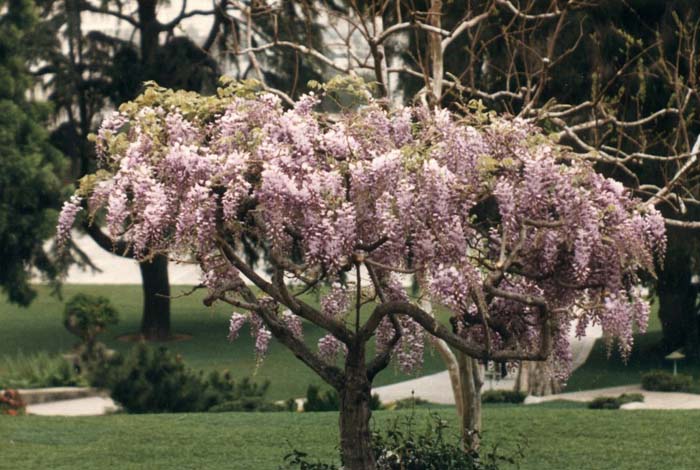Chinese Wisteria Vines
Botany:
Botanically-speaking, it is classified as a deciduous perennial. These vines are in the pea family. Indeed, after its flowers fade, it produces velvety seed pods that resemble pea-pods.
USDA Plant Hardiness Zones:
These vines can be grown in zones 5-8.
Characteristics:
All wisterias are stunning bloomers, bearing large, drooping clusters of fragrant bluish-purple, lavender, mauve or white flowers in late spring to early summer. Chinese wisterias are twining climbers that can wind their way at least 25′ up support. Supports must be sturdy because the mature vines are considerably heavy.
Sun and Soil Requirements:
Likes full sun and a slightly acidic, rich, well-drained soil.
Uses:
Chinese wisteria plants are such vigorous growers that it is not recommended that you let them climb up a porch or the side of your house. Instead, let them grow on a garden shade arbor away from the house. Such arbors, roofed by Chinese wisteria plants, are a perfect focal point for English cottage gardens.
Caveat About Growing This Vine:
In North America, Chinese wisteria plants are considered invasive plants. They are also mildly poisonous plants.
Alternate Spelling: “Wistaria” Vines:
For research purposes, note that, although the spelling I have used is more popular, you will also find the spelling “wistaria” vines. Indeed, the latter spelling is truer to the derivation of the word, which comes from the name, “Caspar Wistar,” a U.S. anatomist. For instance, Sierra Madre, California holds an annual “Wistaria Festival” every March, during which visitors can view a vine that is 111 years old, weighs approximately 250 tons and bears over 1 million lavender blossoms.
Inducing the Vines to Blossom:
If you encounter the problem of inducing the vines to flower (a common problem), try applying a fertilizer high in phosphorus (the middle number in the NPK sequence on fertilizer bags) in early spring. Also try pruning a couple of times each year (in early summer after blooming, and when dormant in winter) to stimulate budding for next year. Root pruning in late fall is sometimes suggested, too, as a stimulant for stubborn vines that just seem to refuse to blossom!
More:
A distinction needs to be made between Chinese wisteria vines (Wisteria sinensis) and Japanese wisteria vines (Wisteria floribunda), on the one hand, and American wisteria vines (Wisteria frutescens), on the other.
One problem with the Chinese and Japanese wisteria vines is waiting for a successful outcome with them — i.e., their flowering. Waiting for them to finally flower can be just too long a wait for some folks, although some growers report success in speeding up their flowering through rigorous pruning (see above). Chinese wisteria plants respond well to pruning, so there’s no need to get fussy with your pruning.
An alternate solution to the long wait for flowering, if you can afford it, is to buy an older (and consequently more expensive) specimen from your nursery. If you shop for Chinese wisteria plants in late spring at nurseries, you can scout for vines already in bloom! Although Chinese wisteria plants tolerate shade, for best blooming grow them in a sunny area.
You may want to buy American wisteria vines, instead. Not only are the latter less invasive, but they also bloom faster, too. Japanese and Chinese wisteria plants are more frost-sensitive as well. American wisteria vines flower in lavender or mauve, and they will sometimes bloom again in September.
Question: Jimmie, we live on a large acreage lot and have a septic system. It is the most unsightly thing you have ever seen. What can I plant around it to help hide it without worrying about roots messing things up? Thank you for your time, Marsha P. in Collin County.
Answer: Hi Marsha, well not sure if your septic tank is the most unsightly thing I have ever seen after being in this business now going on 30 years but I understand your issue.
Your best bet would be to plant Ornamental grasses and perennials around it because their smaller root systems are less likely to cause damage. If you must grow trees or shrubs then you would want to consider things that like to stay wet such as Bald Cypress, Will trees and Oleander shrubs. Until next time…Happy Gardening!!

